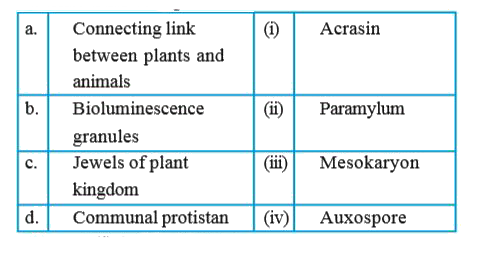In a polymerase chain reaction, temperature required for the steps
(i) Denaturation,
(ii) Annealing and
(iii) Extension are respectively
A)
(
i
)
94
∘
C
(
i
i
)
40
∘
C
(
i
i
i
)
72
∘
C
B)
(
i
)
40
∘
C
(
i
i
)
72
∘
C
(
i
i
i
)
94
∘
C
C)
(
i
)
94
∘
C
(
i
i
)
72
∘
C
(
i
i
i
)
40
∘
C
D)
(
i
)
72
∘
C
(
i
i
)
94
∘
C
(
i
i
i
)
40
∘
C
A) (i)94∘C(ii)40∘C(iii)72∘C
B) (i)40∘C(ii)72∘C(iii)94∘C
C) (i)94∘C(ii)72∘C(iii)40∘C
D) (i)72∘C(ii)94∘C(iii)40∘C
The correct Answer is:A
To solve the question regarding the temperatures required for the steps in a polymerase chain reaction (PCR), we will analyze each step of the PCR process and identify the correct temperatures associated with them.
1. Identify the Steps of PCR:
- The three main steps in PCR are:
- Denaturation
- Annealing
- Extension (or Elongation)
2. Determine the Temperature for Denaturation:
- During the denaturation step, the double-stranded DNA is heated to separate it into two single strands.
- The typical temperature for denaturation is 94°C.
3. Determine the Temperature for Annealing:
- In the annealing step, short DNA primers bind to the single-stranded DNA templates.
- The temperature for annealing is generally lower than that of denaturation and typically falls within the range of 40°C to 60°C. For this question, we can take 40°C as a representative value.
4. Determine the Temperature for Extension:
- In the extension step, DNA polymerase synthesizes new DNA strands by adding nucleotides to the primers.
- The optimal temperature for this step is around 72°C.
5. Compile the Temperatures:
- Now we have the temperatures for each step:
- Denaturation: 94°C
- Annealing: 40°C
- Extension: 72°C
6. Match with the Given Options:
- We need to find the option that matches the temperatures we have identified:
- A) (i) 94°C (ii) 40°C (iii) 72°C
- B) (i) 40°C (ii) 72°C (iii) 94°C
- C) (i) 94°C (ii) 72°C (iii) 40°C
- D) (i) 72°C (ii) 94°C (iii) 40°C
- The correct option that matches our findings is A: (i) 94°C (ii) 40°C (iii) 72°C.
Final Answer:
The correct answer is A) (i) 94°C (ii) 40°C (iii) 72°C.
- The three main steps in PCR are:
- Denaturation
- Annealing
- Extension (or Elongation)
- During the denaturation step, the double-stranded DNA is heated to separate it into two single strands.
- The typical temperature for denaturation is 94°C.
- In the annealing step, short DNA primers bind to the single-stranded DNA templates.
- The temperature for annealing is generally lower than that of denaturation and typically falls within the range of 40°C to 60°C. For this question, we can take 40°C as a representative value.
- In the extension step, DNA polymerase synthesizes new DNA strands by adding nucleotides to the primers.
- The optimal temperature for this step is around 72°C.
- Now we have the temperatures for each step:
- Denaturation: 94°C
- Annealing: 40°C
- Extension: 72°C
- We need to find the option that matches the temperatures we have identified:
- A) (i) 94°C (ii) 40°C (iii) 72°C
- B) (i) 40°C (ii) 72°C (iii) 94°C
- C) (i) 94°C (ii) 72°C (iii) 40°C
- D) (i) 72°C (ii) 94°C (iii) 40°C
- The correct option that matches our findings is A: (i) 94°C (ii) 40°C (iii) 72°C.
The correct answer is A) (i) 94°C (ii) 40°C (iii) 72°C.
Topper's Solved these Questions
- BIOTECHNOLOGY - PRINCIPLES AND PROCESSESBOOK - NCERT FINGERTPS ENGLISHCHAPTER - BIOTECHNOLOGY - PRINCIPLES AND PROCESSESEXERCISE - HOTS
5 Videos
- BIOTECHNOLOGY - PRINCIPLES AND PROCESSESBOOK - NCERT FINGERTPS ENGLISHCHAPTER - BIOTECHNOLOGY - PRINCIPLES AND PROCESSESEXERCISE - NCERT
19 Videos
- BIODIVERSITY & CONSERVATIONBOOK - NCERT FINGERTPS ENGLISHCHAPTER - BIODIVERSITY & CONSERVATIONEXERCISE - Biodiversity & Conservation
140 Videos
- BIOTECHNOLOGY AND ITS APPLICATIONBOOK - NCERT FINGERTPS ENGLISHCHAPTER - BIOTECHNOLOGY AND ITS APPLICATIONEXERCISE - Biotechnology And Its Application
137 Videos
Similar Questions
In an A.C. circuit, irmsandi0 are related as
View SolutionLet IE,ICandIB represent the emitter current,the collector current and the base current respectively in a transistor.then
View SolutionWrite the following sets in set-builder form (i) C={1,−1,i,−i}
View SolutionWrite the following sets in set-builder form (i) C={1,−1,i,−i}
View SolutionFor torsional oscillator, √I/C has dimensions of ? Where C is torsional constant and I is moment of inertia :
View SolutionIf a square matrix such that A2=A , then (I+A)3−7A is equal to A (b) I−A (c) I (d) 3A
View SolutionIf A is square matrix such that A2=A , then (I+A)3−7A is equal to (A) A (B) I−A (C) I (D) 3A
View SolutionIf A is a square matrix such that A2=A,then (I+A)3−7A is equal to: (a)<br>A (b)<br>I−A (c)<br>I (d)<br>3A
View Solution
1 a(iii), b(ii), c(i), d(iv)
2 a(i), b(iv), c(i), d(iii)
3 a(iv), b(i), c(iii), d(iv)
4 a(ii), b(iii), c(iv), d(i)
View SolutionFind the sum r∑i=0.n1Cr−i.n2Ci .
View Solution
